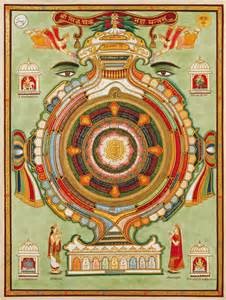For event details, click here.
The Siddhachakra Yantra is the most auspicious and most versatile mystical diagrams in the Jain Religion. The word ‘Siddha’ means liberated soul and ‘Chakra’ means freedom from the karmic cycle. ‘Yantra’ means a mystical diagram. When one worships the Siddhachakra Yantra ones soul becomes liberated from karmic bondages.
According to the Jain tradition the lived at the time of the 20th Tirthankar Munisuvarat Swami who lived approximately 1.1 million years ago. As the story goes King Shripal was suffering from leprosy and was married to Mayanasundari who took him together with 700 lepers to a monk names Munichandra for the cure. The monk instructed them for the cure on how to perform the Siddhachakra Mahapuja with a particular type of fasting known as ‘oli’ which worked.
The diagram represents the whole Jain Dharma which are the nine elements (Nav Pad) and the protective deities. The main section is in the form of an auspicious pitcher (kalash). It has two main components which is the core. Nav Pad which consists of circles 1 and 3 which represents the Siddhachakra which is used in the Poojan. The second main component is the protective rings of deities. The focus on these protectors makes the worldly benefits of the Siddhachakra more understandable and attractive.
In Nav Pad, (1) Arihant means the one who has conquered the inner enemies such as Anger, Greed, Ego and Deceit, (2) Siddha ‘liberated soul’, (3) Acharya ‘spiritual master’, (4) Upadhaya ‘spiritual teacher’, (5) Sadhu ‘monk’. The next four are (6) Darshan ‘Right Faith’, (7) Gyan ‘Right Knowledge’, (8) Charitra ‘Right Conduct’, and (9) Tapa ‘Right Austerities’.
Back to Religion page.

